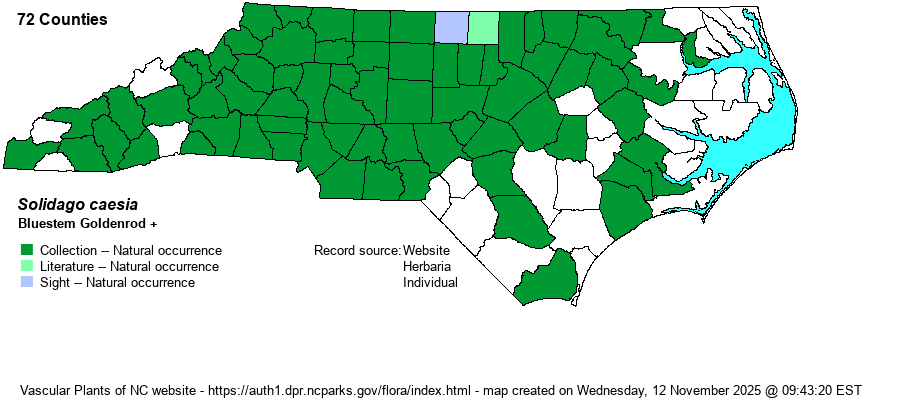| Author | L. | |
| Distribution | Mountains and Piedmont; locally in the Coastal Plain in Piedmont-like habitats (such as slopes along brownwater rivers).
ME to Ont., south to northern FL and LA. | |
| Abundance | Frequent to common in the Piedmont and the northwestern Coastal Plain. Fairly common in the Mountains, but generally uncommon and local in the Coastal Plain; rare to absent in the far eastern counties. This species should have a State Rank of S5 and not just S4S5. | |
| Habitat | Mesic hardwood and pine-hardwood forests, rocky slopes, margins of bottomlands, banks and bluffs of brownwater rivers; locally in limestone soils of Jones County. Favors fairly rich soil in shaded situations, though mainly in uplands. | |
| Phenology | Flowering and fruiting August-October. | |
| Identification | Bluestem Goldenrod is very distinctive in having flowering heads in small clusters in the axils of many of the stem leaves, and also terminally. Plants typically grow 2-3 feet tall and lean at an (often low) angle; leaves are narrowly lance-shape, not toothed. Stems are glaucescent and glabrous. Curtis's Goldenrod (S. curtisii) is similar, but its stems are erect and not glaucescent, and the leaves are broader; it is essentially limited to the mountains. This is a familiar goldenrod of our rich to mesic forested slopes, quite distinctive in its flowers clustered in leaf axils. | |
| Taxonomic Comments | A second variety occurs to the south of NC.
| |
| Other Common Name(s) | Bridal-wreath Goldenrod, Wreath Goldenrod, Axillary Goldenrod | |
| State Rank | S4S5 [S5] | |
| Global Rank | G5 | |
| State Status | | |
| US Status | | |
| USACE-agcp | FACU link |
| USACE-emp | FACU link |

